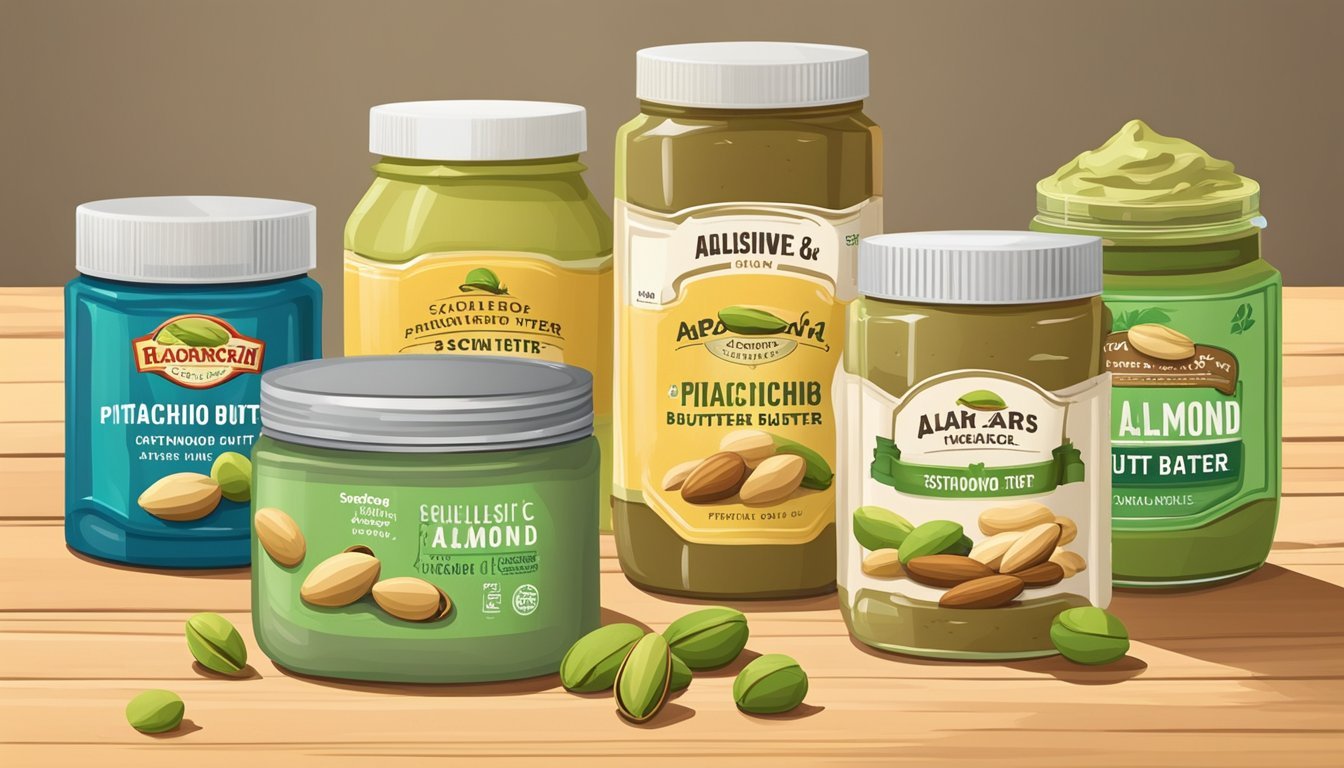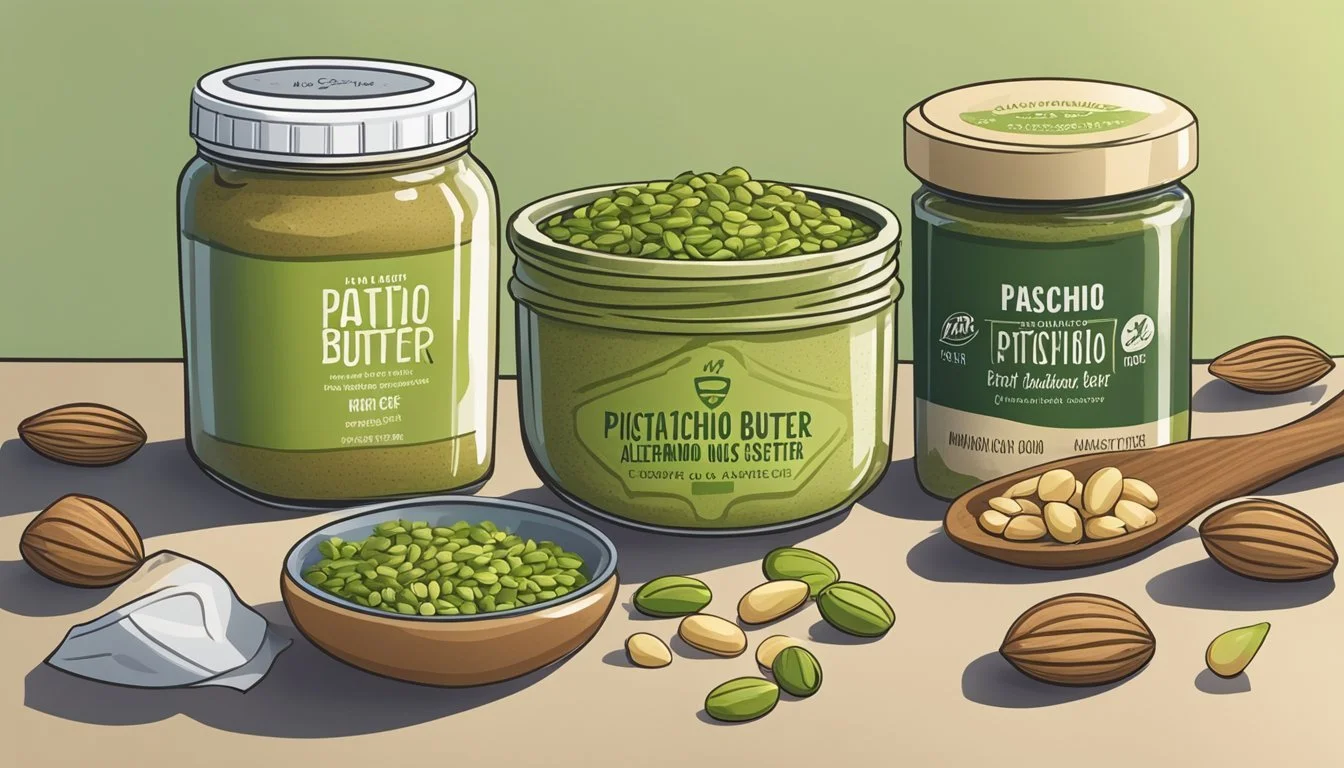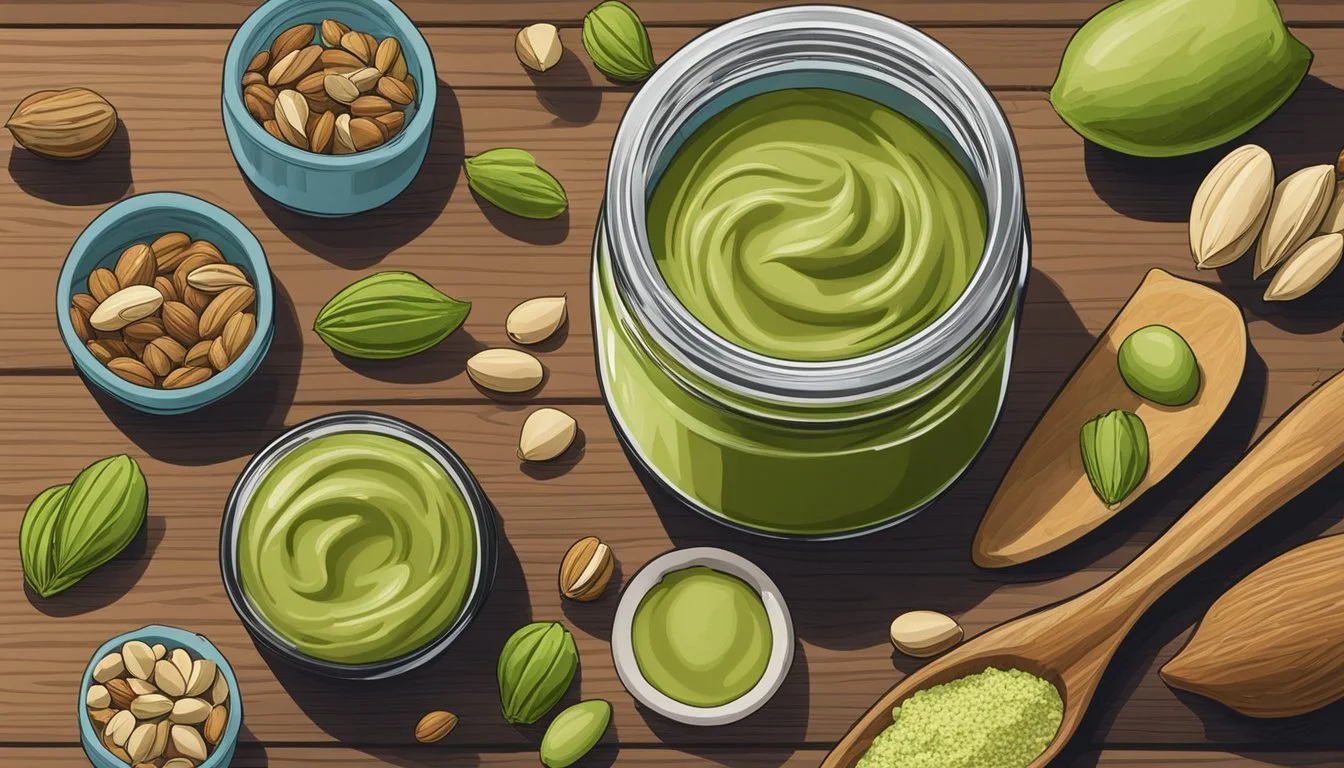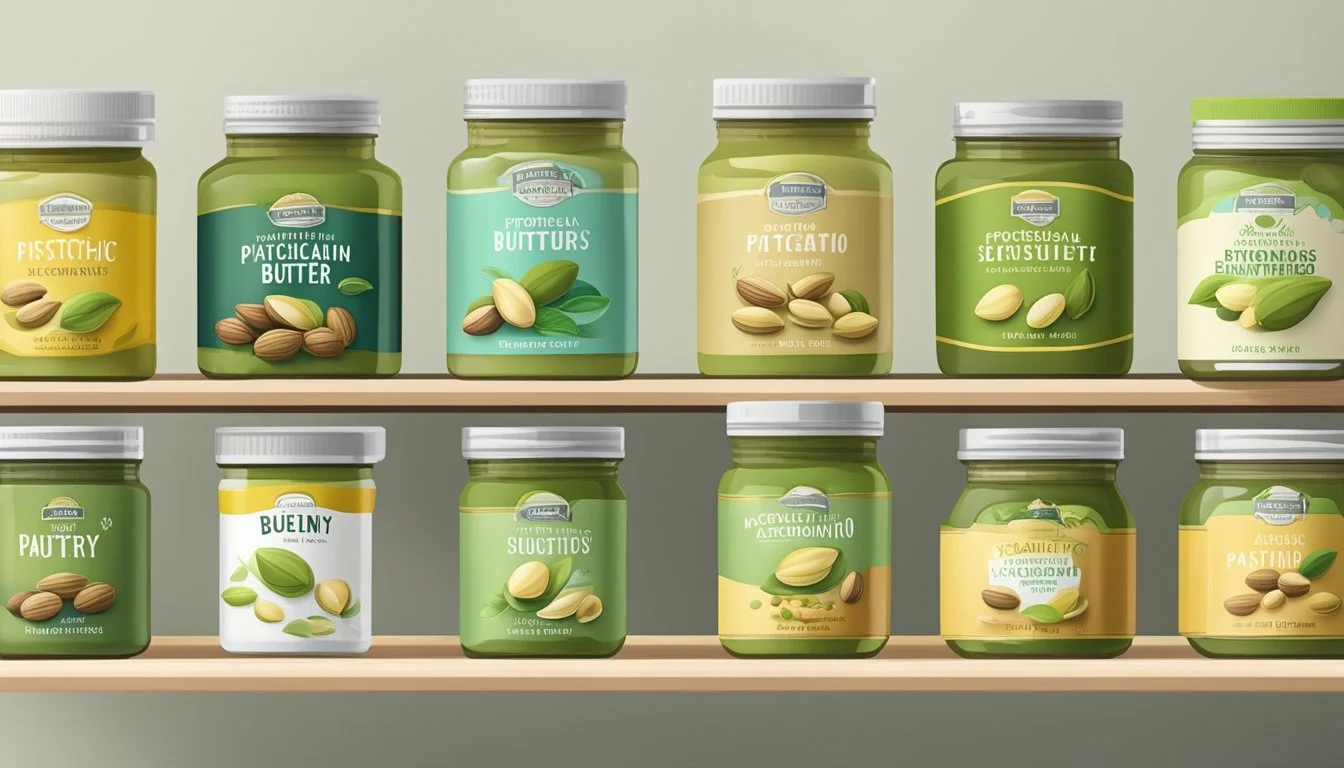Pistachio Butter Substitutes
Top Alternatives for Your Recipes
When it comes to finding substitutes for pistachio butter, there are several delicious and nutritious alternatives available. Almond butter and cashew butter are excellent choices, offering a smooth, rich flavor and a variety of essential micronutrients like vitamin E, magnesium, and potassium. These options not only cater to those with dietary restrictions or allergies but also provide additional health benefits.
For those looking to replace pistachios in recipes, other nuts such as hazelnuts and pine nuts can be effective substitutes. Hazelnuts offer a distinctly nutty taste suitable for baked goods, while pine nuts bring a unique flavor to savory dishes. Both can be used in a 1:1 ratio to replace pistachios in most recipes.
Whole or chopped nuts like blanched almonds are another viable alternative, particularly in recipes where visual appeal is important. Blanched almonds closely resemble the light hue of shelled pistachios, making them ideal for various culinary creations without compromising on the aesthetics.
Understanding Pistachio Butter
Pistachio butter stands out for its rich nutritional content and distinct flavor. It is used in various culinary applications, from spreads to salad dressings. This section explores its nutritional profile, flavor and texture profile, and common uses in cooking and baking.
Nutritional Profile
Pistachio butter is packed with essential nutrients. Each serving is rich in protein, providing the necessary building blocks for muscle repair. It also contains healthy fats which are crucial for heart health.
Additionally, pistachio butter offers vitamins and minerals like vitamin B6, which supports brain function and energy metabolism. Fiber content aids in digestion, and antioxidants help combat oxidative stress. These nutrients make pistachio butter a nutritious option for those looking to boost their diet.
Flavor and Texture Profile
Pistachio butter boasts a distinctive flavor and texture. The taste is slightly sweet and nutty, with a hint of earthiness. Unlike some other nut butters, it maintains a unique roasted flavor that enhances its richness.
The texture can vary from smooth to slightly crunchy, depending on how well the pistachios are ground. Because pistachios are naturally shelled, the butter often has a consistent, creamy texture, perfect for spreading on toast or blending into recipes.
Common Uses in Cooking and Baking
Pistachio butter is versatile in both cooking and baking. It can be used as a spread on toast or crackers, offering a rich and satisfying option for breakfast or snacks. In baking, it adds a unique flavor to cookies, cakes, and pastries.
Another popular use is in salad dressings and sauces, where its creamy texture enhances the overall dish. It can also be incorporated into smoothies, providing a boost of protein and nutrients. Overall, pistachio butter's diverse applications make it a valuable ingredient in the kitchen.
Choosing Pistachio Butter Substitutes
Pistachio butter substitutes vary widely, catering to different dietary restrictions and allergies. Whether you prefer nut-based, seed-based, or nut-free options, there's a suitable alternative available.
Nut-Based Substitutes
Almond butter is a popular choice due to its high vitamin E content. It has a smooth texture and mild flavor, making it versatile for both sweet and savory dishes. Almonds can also be used whole or chopped as a direct replacement in recipes.
Cashew butter provides a rich and creamy texture, ideal for desserts. Its mild flavor makes it a good substitute for pistachio butter in various recipes. Whole or chopped cashews can also be used, especially in creamy or baked dishes.
Macadamia nut butter offers a buttery texture and distinct flavor. It works well in spreads or as an ingredient in baked goods. Macadamia nuts can be used similarly to pistachios but are higher in fats, which imparts a richer taste.
Seed-Based Substitutes
Sunflower seed butter is a great alternative for those with nut allergies. It has a slightly sweet and nutty flavor, making it versatile for various uses. Sunflower seeds can also replace chopped pistachios in recipes.
Pumpkin seed butter provides a unique flavor and is packed with nutrients. It works well in spreads, sauces, and baking. Pumpkin seeds are a good alternative for adding crunch to dishes.
Tahini, made from sesame seeds, is commonly used in Middle Eastern cuisine. It has a rich, slightly bitter taste and creamy consistency. Tahini can be used in sauces, dressings, and baked goods and serves as a nut-free option.
Nut-Free and Allergy-Friendly Alternatives
For a nut-free and allergy-friendly option, sunflower seed butter is highly recommended. It’s suitable for those with nut allergies and offers a comparable texture to nut butters.
Coconut butter can be used as a substitute for pistachio butter. It provides a sweet and tropical flavor, making it a suitable alternative in sweet recipes like desserts and smoothies.
Soy nut butter is another allergy-friendly option. Made from roasted soybeans, it offers a similar texture to peanut butter and can be used in spreads, baking, and cooking. It’s a versatile alternative for those avoiding nuts and seeking a protein-rich substitute.
Making Homemade Substitutes
Homemade substitutes for pistachio butter involve using various nuts and seeds blended into smooth and delicious spreads. These alternatives can be tailored to meet specific flavor and texture preferences by adjusting ingredients and methods.
Recipes for Homemade Nut and Seed Butters
Creating homemade nut and seed butters can start with almonds, cashews, or sunflower seeds. Use a food processor for best results. Here's how:
Almond Butter: Roast 2 cups of almonds at 350°F for 10-12 minutes. Cool, then process until smooth (12-15 minutes). Add salt or honey to taste.
Cashew Butter: Process 2 cups of raw cashews until creamy (about 5-10 minutes). Optionally, roast the cashews first for a deeper flavor.
Sunflower Seed Butter: Toast 2 cups of sunflower seeds lightly. Process until smooth (10-15 minutes). Add salt and a bit of sweetener if desired.
Drain and dry roasted nuts thoroughly before processing for even smoother butter. Ensuring the nuts are warm can also expedite the process.
Adjusting Flavor and Consistency
To achieve the desired flavor and texture, variations can be made. For a sweeter butter, add natural sweeteners like honey, maple syrup, or agave nectar. For a savory touch, incorporate salt, garlic powder, or rosemary.
Altering consistency is straightforward:
For smoother butters, add a tablespoon of neutral oil (e.g., grapeseed or coconut oil).
To thicken, process longer, or add a small amount of flaxseed meal.
Always store nut and seed butters in airtight containers. Refrigeration extends shelf life but may affect spreadability.
Substitute Ratios and Conversions
When substituting pistachio butter in recipes, precise ratios and conversions are essential for achieving the desired taste and texture.
Substitute with a 1:1 ratio: 1 cup macadamia nut butter for 1 cup pistachio butter.
Macadamia nut butter offers a rich, creamy texture that works well in both sweet and savory dishes.
Cashew Butter
Use a 1:1 ratio: 1 cup cashew butter for 1 cup pistachio butter.
Cashew butter provides a slightly sweet flavor, making it ideal for desserts and creamy preparations.
Almond Butter
Apply a 1:1 ratio: 1 cup almond butter for 1 cup pistachio butter.
Blanched almond butter closely matches the color of pistachio butter, offering a similar aesthetic.
Conversion Tips
1 pound nuts in shell = 2 cups of shelled nuts.
1 ounce nuts in shell = about 20 nuts.
1 cup nuts in shell = ½ cup nutmeats.
These conversion tips are valuable for determining how much nut butter to use when working with whole nuts.
Considerations
Flavor profile and texture may vary slightly based on the substitute used.
Adjust the substitution to suit the recipe's specific requirements for sweetness, creaminess, or nutty flavor.
By following these substitution ratios and conversions, one can effectively replace pistachio butter without compromising the quality of the dish.
Health and Dietary Considerations
When choosing a pistachio butter substitute, it’s important to consider the health benefits and how the substitute fits specific dietary restrictions. Key points include the fat content, protein, essential vitamins, and how suitable they are for dietary plans such as vegan, keto, gluten-free, and paleo.
Comparing Fat Content and Nutritional Benefits
Pistachio butter is rich in healthy fats, providing monounsaturated and polyunsaturated fats which are beneficial for heart health. Alternatives like almond butter and cashew butter also contain healthy fats, though their profiles vary slightly.
Almond butter is known for its high vitamin E content, which supports skin health and acts as an antioxidant. It also offers a good amount of magnesium and potassium.
Cashew butter contains fewer calories per serving compared to pistachio butter but offers a creamy texture and a slightly sweeter taste. It is also packed with essential minerals such as iron and zinc.
Both almond and cashew butter contain a significant amount of protein, similar to pistachio butter, making them good choices for those looking to maintain muscle mass or support muscle recovery.
Accommodating for Dietary Restrictions
For those with allergies or specific dietary restrictions, several options are available. Sunflower seed butter offers a nut-free alternative that is rich in vitamins and minerals such as vitamin E and phosphorus.
For a gluten-free and vegan diet, almond and cashew butter are suitable options. They also fit well into paleo and keto diets due to their low carbohydrate content and high fat content.
Coconut butter is another alternative, suitable for keto and paleo diets due to its low carbohydrate content and medium-chain triglycerides (MCTs), which provide a quick source of energy.
Selecting the right substitute depends on individual dietary needs, ensuring that the alternative aligns with health goals and restrictions while offering a similar nutritional profile and benefits as pistachio butter.
Creative Usage Ideas
Pistachio butter can elevate a variety of dishes and snacks with its unique flavor and rich texture. Explore innovative ways to incorporate this nutty delight into your culinary adventures.
Innovative Cooking and Baking Ideas
Transform everyday recipes by adding pistachio butter. It can be used in both sweet and savory dishes. For instance, swirl it into batter for cookies or brownies to add a nutty richness.
Mix pistachio butter into oatmeal or pancake batter for a creamy and indulgent breakfast. It can serve as a unique icing or filling for cakes and tarts.
In savory recipes, use it as a base for salad dressings or sauces. Blend pistachio butter with olive oil, lemon juice, and herbs for a delicious salad dressing.
Beyond Meals: Snacks and Other Treats
Incorporate pistachio butter into your snacks for a nutritious boost. Spread it on toast or pair it with fruits like apples and bananas. It makes a delightful dip for vegetable sticks or crackers.
Create delightful homemade granola bars or trail mixes by mixing pistachio butter with oats, nuts, and dried fruits. Consider adding it as a topping for ice cream or yogurt for an indulgent yet nutritious treat.
Lastly, make your baked goods special by using pistachio butter in muffins or scones, giving them a unique flavor twist.
Storing Substitutes for Longevity
For optimal storage of pistachio butter substitutes, airtight containers are essential. These containers minimize exposure to air, which can cause nuts and seeds to go rancid. Choose sturdy containers like Tupperware, glass jars with tight lids, or high-quality plastic bags with strong seals.
Store these substitutes in a cool, dry place. Ideal temperatures range between 32°F (0°C) and 50°F (10°C). Such conditions help maintain the freshness of the butter substitutes, preventing degradation and preserving flavor.
If space permits, refrigeration can extend the shelf life further. Always use airtight containers when refrigerating to protect the contents from moisture and odors from other foods.
For those who need long-term storage options, freezing is effective. Wrap the substitutes in aluminum foil or their original packaging before placing them in an airtight container or freezer bag. This added layer of protection helps maintain quality.
When choosing a location within your kitchen, avoid areas with frequent temperature fluctuations like spots near ovens or windows. Instead, select a pantry or cabinet that remains relatively stable throughout the day.
Adhering to these guidelines ensures that pistachio butter substitutes retain their intended taste and texture for as long as possible.
Considerations on Cost and Availability
When seeking substitutes for pistachio butter, cost and availability are key factors. Different nuts and seeds vary significantly in price and how easily they can be found in different regions, which can affect both the selection and final cost of your recipes.
Comparing Prices of Nuts and Seeds
Almonds: Almonds are often more affordable than pistachios and can be found in both whole and processed forms, such as almond flour or almond butter. The price can vary depending on whether they are blanched or unblanched.
Cashews: Cashews offer a rich, sweet flavor and are similarly priced to pistachios. They are widely available in most grocery stores, making them a convenient substitute.
Hazelnuts: Hazelnuts can be a bit pricier. Their distinct taste makes them a good option for certain recipes, but they may not be as cost-effective if your budget is a concern.
Walnuts and Pecans: These nuts are generally priced in a similar range to pistachios, but their flavor profiles can differ significantly. They are readily available but might not match the specific taste of pistachio butter as closely as almonds or cashews.
Regional Availability and Quality
The availability and quality of nuts and seeds can vary by region. Almonds, for instance, are abundantly grown in California, making them easily accessible in the U.S. Cashews are imported from countries like India and Vietnam, ensuring steady availability in many regions.
Hazelnuts primarily come from Turkey and Italy. While they are of high quality, there may be occasional shortages depending on export conditions.
Walnuts and pecans are native to North America, ensuring consistent quality and supply within the continent. Brazil nuts are sourced from South America and may be less readily available but offer a distinct flavor profile.
Understanding local markets can help determine the best alternative both in terms of cost and accessibility, ensuring you select the most effective substitute for pistachio butter in your culinary endeavors.
Specialty Substitutes
When searching for specialty substitutes for pistachio butter, it's important to consider both gourmet alternatives and how different flavor profiles can affect the outcome of your recipes. Each substitute brings its unique characteristics and benefits.
Gourmet and Artisanal Alternatives
Macadamia Nut Butter
Macadamia nut butter is a luxurious choice. It offers a rich, creamy texture and a buttery flavor. High in healthy monounsaturated fats and vitamins, it can enhance numerous dishes. This butter’s indulgent taste makes it stand out, especially in desserts and creamy dishes.
Pecan Butter
Pecan butter provides a sweet, nutty flavor. Its smooth consistency is perfect for spreads and baking. Rich in antioxidants, pecan butter not only substitutes well for pistachio butter but also adds a unique touch to recipes.
Pistachio Oil
Pistachio oil is another artisanal substitute. It maintains the essential essence of pistachios. Use it sparingly in dressings or drizzled over dishes. This oil adds a distinctive, nutty aroma and taste without altering the texture.
Adapting to Flavor Preferences
Sweetness Adjustment
When using alternatives like macadamia nut butter or pecan butter, be mindful of their naturally sweeter profiles. This can complement desserts and sweet dishes. Adjust other sweet ingredients accordingly to maintain balance.
Texture Considerations
Pistachio oil, while not a direct substitute for butter, can provide the nutty flavor root. Use it in recipes where the texture of butter isn’t crucial. Combining it with other substitutes can get the right flavor and consistency.
Pairings
Consider using pear or apple slices to complement these substitutes. Their mild flavors balance the richness of the nuts and add a fresh element. This can be particularly effective in salads or as a snack.
Selecting the right substitute depends on the specific needs of your recipe, from texture to flavor.









